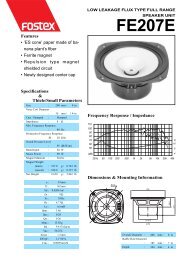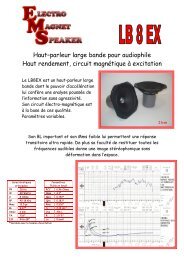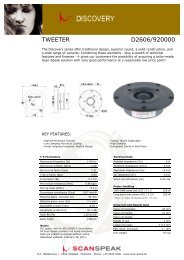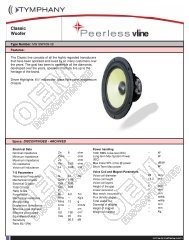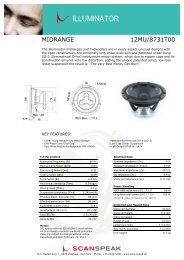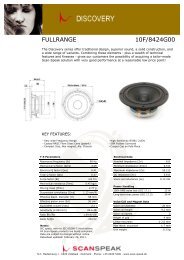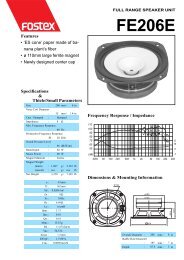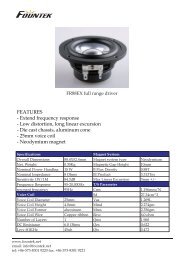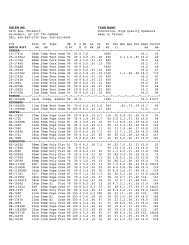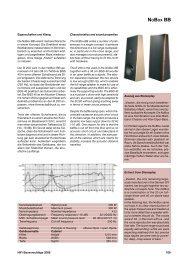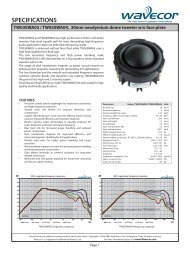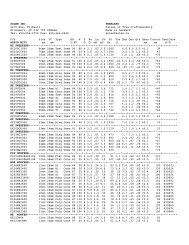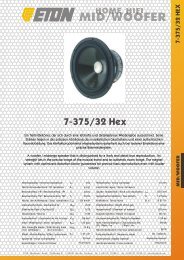Erfolgreiche ePaper selbst erstellen
Machen Sie aus Ihren PDF Publikationen ein blätterbares Flipbook mit unserer einzigartigen Google optimierten e-Paper Software.
<strong>MonItor</strong> <strong>890</strong> <strong>MK</strong> <strong>III</strong><br />
Auszug aus Image HiFi (<strong>MK</strong> II)<br />
„Die Monitor <strong>890</strong> <strong>MK</strong> II hat den idealerweise nicht<br />
zu kleinen Hörraum auch bei leiseren Pegeln souverän<br />
im Griff. Das ausgezeichnete Mitteltonhorn<br />
läßt beispielsweise Gesangsstimmen oder Naturinstrumente<br />
bei voller Durchzeichnung ohne jede<br />
Giftigkeit erklingen. Die ganze Skala tonaler<br />
Feinheiten wird für ein Hornsystem frappierend<br />
differenziert aufgelöst, zudem mit einer Klarheit<br />
und dynamischer Kontur, die weniger effizienten<br />
Wandlern fehlt. Erfreulicherweise läßt sich auch<br />
das Hochtonhorn bei geschickter Pegeleinstellung<br />
nicht als Fragment heraushören und integriert<br />
sich ansatzlos in das phänomenal durchsichtige<br />
Klangbild.“ „ Die Kombination aus purer<br />
Kraft und feingeistigen Manieren macht deshalb<br />
für mich die besondere Anziehungskraft der Monitor<br />
<strong>890</strong> <strong>MK</strong> II aus.“ Testurteil: ausgezeichnet<br />
extract from Image HiFi (<strong>MK</strong> II)<br />
„The Monitor <strong>890</strong> <strong>MK</strong> II deals beautifully with<br />
the full range even down to even low output levels<br />
provided the listening area is not too small.<br />
The excellent mid-range horn reproduces voices<br />
and non-amplified instruments beautifully without<br />
the slightest over-emphasis and right across<br />
the frequency range. The full range of tonal sophistication<br />
is remarkably well differentiated for<br />
a horn-based system, and this with a clarity and<br />
dynamism that is missing in less powerful drivers.<br />
We were pleased to find that, provided the<br />
output level is well chosen, the high-range horn<br />
does not stand out on its own as a fragment of<br />
the picture but blends in well to the impressive<br />
overall panorama.“ „This combination of pure<br />
power and sophisticated manners was what irresistibly<br />
attracted me to the Monitor <strong>890</strong> <strong>MK</strong> II.“<br />
Verdict: excellent<br />
Eigenschaften und Klang<br />
Bekanntlich gibt es zwei Arten von Lautsprecherboxen:<br />
HiFi-Boxen, bei denen<br />
es um höchste Wiedergabetreue geht<br />
und Musiker- oder auch Disco-Boxen,<br />
die auf höchste Lautstärke gezüchtet<br />
sind. Diese Lautstärke ist im Allgemeinen<br />
nur mit Hörnern zu realisieren, die leider<br />
oft Klangverfärbungen mit sich bringen.<br />
Die <strong>MonItor</strong> <strong>890</strong> <strong>MK</strong> <strong>III</strong> soll diese<br />
beiden Ziele „unter einen Hut“ bringen.<br />
Im Mitteltonbereich arbeitet eine Treiber-Horn-Einheit,<br />
die im Hinblick auf ihre<br />
Dynamik und Verfärbungsarmut schon<br />
manchen Horngegner in Erstaunen versetzt<br />
hat. Die beiden High-End-Tieftöner<br />
TIW 300 erzeugen im 180 l-Bassreflexgehäuse<br />
einen physisch spürbaren<br />
Bassdruck, wie man ihn von Musikerboxen<br />
gewohnt ist. Im Zusammenspiel<br />
mit dem exzellenten Hochtonhorn TL<br />
16 H ist eine Lautsprecherkombination<br />
entstanden, die den unüberbrückbar erscheinenden<br />
Gegensatz zwischen HiFi-<br />
und Profiboxen aufhebt.<br />
Der Pegel des Mittel- und des Hochtöners<br />
kann mit Hilfe von Pegelreglern an<br />
die Einsatzbedingungen der Lautsprecher<br />
angepasst werden. Wir empfehlen<br />
als Grundeinstellung folgende Einstellung<br />
der Pegelregler: Hochton: -4 dB;<br />
Mittelton: -4 dB. In Abhängigkeit von<br />
Raumakustik und Hörgewohnheiten<br />
können diese Einstellungen verändert<br />
werden.<br />
Die Frequenzweiche der <strong>MonItor</strong> <strong>890</strong> <strong>MK</strong><br />
<strong>III</strong> enthält eine Impedanzlinearisierung,<br />
so dass sie auch für den Betrieb an kritischen<br />
Verstärkern (z.B. Röhrenendstufen)<br />
bestens geeignet ist.<br />
Nennbelastbarkeit Rated power 600 W<br />
Musikbelastbarkeit Maximum power 900 W<br />
Nennimpedanz Nominal impedance 4 Ω<br />
Übertragungsbereich Frequency response (–10 dB) 30–35 000 Hz<br />
Mittl. Schalldruckpegel Mean sound pressure level 94 dB (1 W/1 m)<br />
Trennfrequenz Cut-off frequency 800 / 7500 Hz<br />
Gehäuseprinzip Principle of Housing Bassreflex / bass reflex<br />
Gehäusemaße Cabinet<br />
Nettovolumen Net volume 180 l<br />
Höhe Height 1070 mm<br />
Breite Width 688 mm<br />
Tiefe Depth 508 mm<br />
Characteristics and sound properties<br />
It is well-known that there are two types<br />
of loudspeakers: hi-fi speakers that produce<br />
the most accurate, unaltered sound<br />
possible, and disco or musician‘s speakers,<br />
where the top volume level is of the<br />
utmost importance. These volume levels<br />
are normally only possible with horns<br />
but these often cause coloration of the<br />
sound. The <strong>MonItor</strong> <strong>890</strong> <strong>MK</strong> <strong>III</strong> was designed<br />
specifically to combine the best<br />
of both worlds. In the mid-range, we use<br />
a driver & horn unit which is so dynamic<br />
and produces such undistorted music,<br />
that many a horn-disparager has had to<br />
admit that this is simply unbelievably „different“.<br />
Two excellent quality woofers,<br />
TIW 300, mounted in the 180 litre vented<br />
cabinet, generate a bass sound pressure<br />
that is physically tangible, as you<br />
have experienced with concert speakers.<br />
Combined with the first-rate TL 16 H<br />
high-range horn, we have created a loudspeaker<br />
system that breaks down the<br />
previously unbridgeable barrier between<br />
the hi-fi and the professional speaker.<br />
The output levels of the mid-range driver<br />
and tweeter can be adjusted to the<br />
requirements of the locale using output<br />
controls. We recommend, initially<br />
at least, the following level settings:<br />
tweeter: -4 dB; mid-range: -4 dB. These<br />
can, of course, be adapted to suit the<br />
specific acoustics in the room and personal<br />
preferences.<br />
Thanks to the added impedance linearizing<br />
unit in the crossover unit, the Mon-<br />
Itor <strong>890</strong> <strong>MK</strong> <strong>III</strong> is now even better suited<br />
to use with critical amplifiers (e.g. tube<br />
amplifiers).<br />
100 HiFi Bauvorschläge 2008
Auszug aus STEREO (<strong>MK</strong> II)<br />
„... was dieser untersetzte Bolide an Bass in den<br />
Hörraum stampft, läßt einiges von dem, was<br />
man sonst so gewohnt ist, mit einem Mal deutlich<br />
müder erscheinen. Präzise, aber mit ungeheurer<br />
Kraft knallten und krachten uns die Impulse<br />
nur so um die Ohren. Man zuckt regelrecht<br />
zusammen. Dabei übertreibt die Visaton keineswegs,<br />
tatsächlich ordnet sich der Tieftonbereich<br />
sehr gut ins Klangbild ein, pumpt vor allem nicht<br />
mühsam hinterher. Der Hochtonbereich kommt<br />
luftig und mit hoher Feinauflösung. Schnelligkeit<br />
und Plastizität des Hochtonhorns sind spitze,<br />
auch die Raumabbildung gelingt.“ „Die Monitore<br />
‚können‘ Discomusik genau so brachial<br />
und knackig, wie sie sein soll, lassen wahlweise<br />
mit Pink Floyd oder Orgelmusik solideste Burgmauern<br />
erzittern und trotzdem ist es durchaus<br />
ein Genuß, mit ihnen auch einmal einer Sinfonie<br />
zu lauschen. Die Gratwanderung zwischen HiFi-<br />
und Profi-Lautsprechern scheint geglückt.“ „Visatons<br />
Monitore sind mehr als ‚nur‘ Gute-Laune-<br />
Boxen. Bei ihnen verbinden sich horntypische<br />
Stärken wie Schalldruck und Temperament auf<br />
harmonische Art und Weise mit Klangfarbentreue<br />
und Allroundtauglichkeit - super!“<br />
Testurteil: exzellent<br />
Auszug aus Klang & Ton (<strong>MK</strong> II)<br />
„Den benötigten Platz und einen toleranten Lebenspartner<br />
vorausgesetzt, können wir dieses<br />
Kleinod großer Boxenbaukunst jedem Liebhaber<br />
fetzigen Gitarrenrocks bis hin zu einfühlsamen<br />
Rythm & Blues wärmstens ans Herz legen. Obwohl<br />
der Monitor auch bei klassischer Musik<br />
und kleinem Pegel nicht versagte, liegt seine<br />
große Stärke eindeutig in der exzellenten Darstellung<br />
live-haftiger Ereignisse, temperamentvoll,<br />
dynamisch, gut.“<br />
<strong>MonItor</strong> <strong>890</strong> <strong>MK</strong> <strong>III</strong><br />
extract from STeReO (<strong>MK</strong> II)<br />
„... this chunky character pounds out bass levels<br />
that make a lot of other speaker systems look<br />
pretty puny. The sounds washed around our ears<br />
precisely but unmistakably and very powerfully. It<br />
was enough to make you wince. But this Visaton<br />
model does not overdo it. The bass production is<br />
well balanced against the higher ranges to produce<br />
a tidy overall picture where the bass does<br />
not have trouble keeping up. The high range retains<br />
an airy feel and is very clearly defined. The<br />
horn‘s response and depth of sound are excellent,<br />
and its spatial positioning is a dream.“<br />
„The Monitor system can produce disco music<br />
just the way the kids like it, can make the walls<br />
of your nearest castle vibrate with Pink Floyd<br />
or some good organ music and yet it is still a<br />
real treat to listen to a symphony on the same<br />
speakers. This precarious fine line between hi-fi<br />
and professional speaker system has been very<br />
well mastered.“<br />
„Visaton‘s Monitor speakers are more than just<br />
a pleasant sensation. They combine the typical<br />
strengths of a horn system like sound pressure<br />
and temperament with such features as accuracy<br />
of depth and allround abilities brilliant!“<br />
Verdict: excellent<br />
extract from Klang & Ton (<strong>MK</strong> II)<br />
„Provided you have enough space and a very<br />
tolerant partner, we can warmly recommend this<br />
major contribution to the art of building speakers<br />
to every aficionado of lively guitar-based rock<br />
through to subtle and sophisticated rhythm &<br />
blues. Although the Monitor set-up is perfectly<br />
capable of reproducing classical musical and<br />
can cope with lower volume ranges, its strength<br />
is definitely in the excellent representation of<br />
live-sounding events, full of temperament and<br />
dynamism.“<br />
HiFi Bauvorschläge 2008 101
<strong>MonItor</strong> <strong>890</strong> <strong>MK</strong> <strong>III</strong><br />
Bestückungsliste für 1 Box<br />
Der Bausatz enthält alle in dieser Bestückungsliste<br />
aufgeführten Bauteile,<br />
jedoch kein Gehäuse.<br />
Hochtonhorn TL 16 H - 8 Ω 1 St.<br />
Mitteltontreiber DR 45 N - 8 Ω 1 St.<br />
Adapter AD 25 H 1 St.<br />
Horn M 300 (MDF roh) 1 St.<br />
Boxenfüße Buche 3 St.<br />
Tieftöner TIW 300 - 8 Ω 2 St.<br />
Frequenzweiche<br />
„<strong>MonItor</strong> <strong>890</strong> <strong>MK</strong> <strong>III</strong>“<br />
Pegelregler<br />
Anschluss-<br />
LC 95 2 St.<br />
klemme BT 95/75 2 St.<br />
Dämpfungs- PolyestermaterialSpezialwolle<br />
7 Btl.<br />
Holzschrauben 5 x 30 mm 16 St.<br />
Holzschrauben 4 x 20 mm<br />
Senk-<br />
8 St.<br />
kopfschrauben 3,5 x 25 mm 8 St.<br />
Kabel 2 x 2,5 mm² 3,5 m<br />
2 x 1,5 mm² 3,5 m<br />
Component parts list for 1 box<br />
The kit includes all the components<br />
listed here but not the cabinet.<br />
Tweeter TL 16 H - 8 Ω 1 pc.<br />
Mid-range<br />
driver DR 45 N - 8 Ω 1 pc.<br />
Adapter AD 25 H 1 pc.<br />
Horn M 300 (MDF) 1 pc.<br />
Speaker<br />
stands beech 3 pcs.<br />
Woofer TIW 300 - 8 Ω 2 pcs.<br />
Crossover „<strong>MonItor</strong> <strong>890</strong> <strong>MK</strong> <strong>III</strong>“<br />
Level control LC 95 2 pcs.<br />
Terminal BT 95/75 2 pcs.<br />
Damping Polyester<br />
material wool 7 bags<br />
Special wood<br />
screws 5 x 30 mm 16 pcs.<br />
Wood screws 4 x 20 mm 8 pcs.<br />
Countersunk<br />
screws 3.5 x 25 mm 8 pcs.<br />
Cable 2 x 2.5 mm² 3.5 m<br />
2 x 1.5 mm² 3.5 m<br />
Zuschnittliste für 1 Box<br />
Teile Maße (mm) Anzahl<br />
Material: 19 mm MDF oder Spanplatte<br />
Deckel und Boden 688 x 508 2<br />
Schallwand 782 x 380 1<br />
Rückwand 782 x 280 1<br />
Hintere Seitenwand 782 x 283 2<br />
Mittlere Seitenwand 782 x 150 2<br />
Vordere Seitenwand 782 x 212 2<br />
Seiten Reflexkanal 91 x 79 2<br />
Oberteil Reflexkanal 91 x 342 1<br />
Eckversteifungen 80 x 294 4<br />
Versteifung 105 x 444 1<br />
Versteifung 100 x 782 2<br />
Seitenleisten 50 x 782 2<br />
Sockelplatte 630 x 450 1<br />
Cabinet parts list for 1 box<br />
Parts Size (mm) Quantity<br />
Material: 19 mm chipboard or MDF<br />
Top and bottom<br />
panel 688 x 508 2<br />
Front panel 782 x 380 1<br />
Rear panel 782 x 280 1<br />
Rear side panel 782 x 283 2<br />
Middle side panel 782 x 150 2<br />
Front side panel 782 x 212 2<br />
Sides bass-reflex<br />
channel 91 x 79 2<br />
Top bass-reflex<br />
channel 91 x 342 1<br />
Brace 80 x 294 4<br />
Brace 105 x 444 1<br />
Brace 100 x 782 2<br />
Strip 50 x 782 2<br />
Base 630 x 450 1<br />
102 HiFi Bauvorschläge 2008
Aufbau<br />
Das achteckige Gehäuse sieht komplizierter<br />
aus, als es in Wirklichkeit ist. Alle<br />
Schmiegen (bis auf zwei Ausnahmen<br />
mit 45°) werden in demselben Winkelanschlag<br />
geschnitten (22,5°). Beim Einrichten<br />
der Säge sollte das Blatt ein wenig<br />
über 22,5° eingestellt werden. Dadurch<br />
wird sichergestellt, dass die Schmiegen<br />
an der Außenseite wirklich dicht sind.<br />
Als Erstes werden in die zugeschnittenen<br />
Bretter die entsprechenden Ausschnitte<br />
gesägt, und zwar die zwei Durchmesser<br />
für die Basslautsprecher, die rechteckige<br />
Aussparung für den Reflextunnel und die<br />
beiden für die Pegelregler.<br />
Nun wird der Korpus ohne Boden und<br />
Deckel aufgebaut. Beim Verleimen wird<br />
reichlich Klebeband zum Fixieren der<br />
Seitenwände benötigt. Die Teile für den<br />
Bassreflextunnel, die vier Versteifungen<br />
an den Seitenwänden und die senkrecht<br />
durchgehenden Versteifungen (50 mm<br />
breit) an der Schallwand werden eingepasst.<br />
Der Boden muss dann an den fertig<br />
verleimten Korpus angepasst werden,<br />
da ein millimetergenauer Zusammenbau<br />
des Korpus kaum möglich ist. Nun<br />
werden die senkrechten Versteifungen<br />
mit dem Boden und die Versteifung zwischen<br />
Schall- und Rückwand verleimt.<br />
Der Deckel mit dem Ausschnitt für das<br />
Anschlussterminal für Hoch- und Mitteltöner<br />
wird angepasst und verleimt. Die<br />
beiden Frequenzweichenplatinen werden<br />
auf der Rückwand gegenüber dem unteren<br />
Basslautsprecher befestigt. Für die<br />
Verkabelung der Hörner reicht ein Querschnitt<br />
von 1,5 mm² aus. Vom Terminal<br />
zu den Platinen und zu den Tieftönern<br />
sollte Kabel mit 2,5 mm² Querschnitt verwendet<br />
werden.<br />
In den rechteckigen Ausschnitt der Deckplatte<br />
wird ein Doppelterminal zum Anschluss<br />
der Mittel- und Hochtonhörner<br />
eingesetzt. Die beiden vergoldeten Brücken<br />
müssen hierfür natürlich entfernt<br />
werden.<br />
Das Mitteltonhorn wird mit den drei zylindrischen<br />
Boxenfüßen auf die Deckelplatte<br />
des Gehäuses gestellt. Der Hochtöner<br />
liegt auf dem beiliegenden Holzfuß<br />
und wird im hinteren Bereich auf das<br />
Mitteltonhorn gestellt. Die Position der<br />
beiden Hörner ist wichtig für die Akustik,<br />
sie sollten deshalb gemäß Zeichnung<br />
platziert werden.<br />
Construction<br />
This octagonal cabinet looks more complicated<br />
than it really is. All the chamfers<br />
are cut at 22.5° except two (at 45°).<br />
When you set up the saw, it is best to<br />
cut fractionally over 22.5° to ensure that,<br />
on the outside, all the chamfers are really<br />
airtight.<br />
First cut the required cut-outs in the<br />
boards, which have already been cut to<br />
size. The two circular ones for the bass<br />
loudspeakers, the square opening for<br />
the tunnel and the two for the level controller.<br />
Next, build the main body without the<br />
base and top. You will need plenty of<br />
sticky tape to hold the joints together<br />
when gluing the side panels. The parts<br />
for the tunnel, the four stiffeners on the<br />
side panels and the vertical stiffeners (50<br />
mm wide) on the front baffle then need<br />
to be shaped to an exact fit. The base<br />
then has to be shaped to fit exactly in the<br />
completed main body, since it is hardly<br />
possible to build the body with millimetre<br />
accuracy. Next, glue the vertical stiffeners<br />
to the base and the stiffener between<br />
the baffle and the rear panel.<br />
The top with its cut-out for the terminals<br />
for the high- to mid-range is then<br />
shaped to fit and glued in position. The<br />
two crossover circuit boards are attached<br />
to the rear panel opposite the lower bass<br />
speaker drivers. The wiring to the horns<br />
need not be heavier than 1.5 mm 2 . From<br />
the terminals to the circuit boards and<br />
to the woofers, use wires with a crosssection<br />
of 2.5 mm 2 .<br />
The twin terminal unit for connecting the<br />
mid- to high-range horns is fitted in the<br />
square cut-out in the top. The two goldcoloured<br />
jumpers have to be removed<br />
to do this.<br />
The mid-range horn is placed on top of<br />
the cabinet on its three cylindric feet.<br />
The tweeter is mounted on the wooden<br />
base supplied and is placed on top of<br />
the mid-range horn, towards the rear.<br />
The position of the two horns is crucial<br />
to the acoustics and, for this reason, they<br />
should be positioned as shown in the<br />
drawings.<br />
<strong>MonItor</strong> <strong>890</strong> <strong>MK</strong> <strong>III</strong><br />
Bedämpfung<br />
Siehe Zeichnung<br />
Inner damping<br />
See drawing<br />
HiFi Bauvorschläge 2008 10
10 HiFi Bauvorschläge 2008



